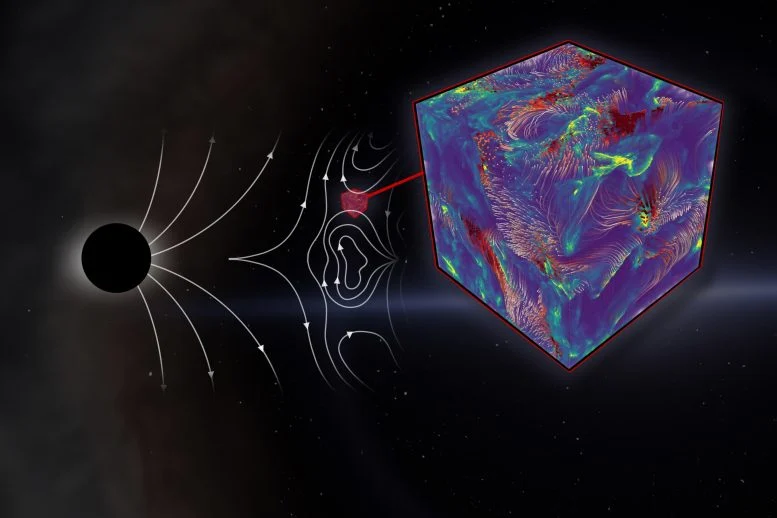
By University of Helsinki August 23, 2024
Collected at: https://scitechdaily.com/solving-the-puzzle-of-x-ray-radiation-from-black-holes/
Researchers at the University of Helsinki have advanced our understanding of black holes using supercomputer simulations, revealing how magnetic fields cause turbulence that heats plasma and produces X-ray radiation observable from Earth.
Their groundbreaking study, which included all significant quantum interactions between radiation and plasma, shows that the plasma around black holes can exist in two states, contributing significantly to our knowledge of cosmic phenomena.
Using detailed supercomputer simulations, scientists at the University of Helsinki modeled the interactions between radiation, plasma, and magnetic fields around black holes. It was found that the chaotic movements, or turbulence, caused by the magnetic fields heat the local plasma and make it radiate.
Understanding Black Hole Dynamics
A black hole is created when a large star collapses into such a dense concentration of mass that its gravity prevents even light from escaping its sphere of influence. This is why, instead of direct observation, black holes can only be observed through their indirect effects on the environment.
Most of the observed black holes have a companion star, with which they form a binary star system. In the binary system, the two objects orbit each other, and the matter of the companion star slowly spirals into the black hole. This slowly flowing stream of gas often forms an accretion disk around the black hole, a bright, observable source of X-rays.
Advanced Modeling of Accretion Disks
Since the 1970s, attempts have been made to model the radiation from the accretion flows around the black holes. At the time, X-rays were already thought to be generated through the interaction of the local gas and magnetic fields, similar to how the Sun’s surroundings are heated by its magnetic activity via solar flares.
“The flares in the accretion disks of black holes are like extreme versions of solar flares,” says Associate Professor Joonas Nättilä. Nättilä heads the Computational Plasma Astrophysics research group at the University of Helsinki, which specializes in modeling precisely this kind of extreme plasma.
Quantum Phenomena in Plasma Dynamics
The simulations demonstrated that the turbulence around the black holes is so strong that even quantum effects become important for the plasma dynamics.
In the modeled mixture of electron-positron plasma and photons, the local X-ray radiation can turn into electrons and positrons, which can then annihilate back into radiation, as they come in contact.
Nättilä describes how electrons and positrons, antiparticles to one another, usually do not occur in the same place. However, the extremely energetic surroundings of black holes make even this possible. In general, radiation does not interact with plasma either. However, photons are so energetic around black holes that their interactions are important to plasma, too.
“In everyday life, such quantum phenomena where matter suddenly appears in place of extremely bright light are, of course, not seen, but near black holes, they become crucial,” Nättilä says.
“It took us years to investigate and add to the simulations all quantum phenomena occurring in nature, but ultimately, it was worth it,” he adds.
Insights From Turbulent Plasma and Radiation
The study demonstrated that turbulent plasma naturally produces the kind of X-ray radiation observed from the accretion disks. The simulation also made it possible, for the first time, to see that the plasma around black holes can be in two distinct equilibrium states, depending on the external radiation field. In one state, the plasma is transparent and cold, while in the other, it is opaque and hot.
“The X-ray observations of black hole accretion disks show exactly the same kind of variation between the so-called soft and hard states,” Nättilä points out.
The study was published in the esteemed journal Nature Communications. The simulation used in the study is the first plasma physics model to include all the important quantum interactions between radiation and plasma.
Reference: “Radiative plasma simulations of black hole accretion flow coronae in the hard and soft states” by Joonas Nättilä, , 15 August 2024, Nature Communications.
DOI: 10.1038/s41467-024-51257-1
The study is part of a project headed by Nättilä and funded with a €2.2 million Starting Grant from the European Research Council, which aims to understand interactions between plasma and radiation.

Leave a Reply